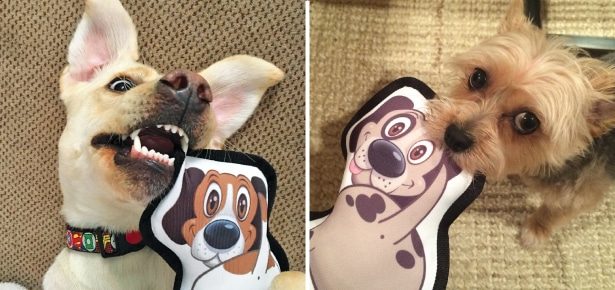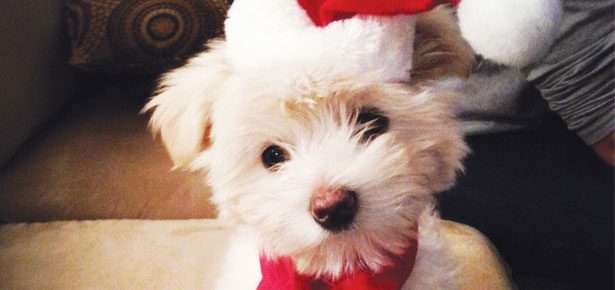

Distract Me!
Improve your dog's obedience and focus
I’m amazed at how well-behaved most Manhattan dogs are. With buses roaring by, taxis horns blaring, jaywalkers shuttling en masse across major streets, New York dogs of all shapes and sizes seem unperturbed, unflappable, just like their owners. Yet, despite the city chaos, if a NYC owner pulls out a cookie or gives a command, the dog pays attention and performs. How do these dogs get to be so levelheaded and focused?
In a word, it’s desensitization. Dogs who grow up in busy environments become habituated to noise, crowds, and chaos. It’s basically a calmness arrived at via a slow, premeditated overload of the pet’s senses.
Most dog owners do the bulk of obedience training in the quiet, familiar surroundings of home. But if home is the only place you train, then that’s the only place your dog will listen. Though fine for teaching new behaviours, training your dog in and around the home limits how well she can master a behaviour. For instance, if taught to come only in your living room or back yard, your pooch won’t obey you at a busy soccer meet or on a hectic street. Hesitation or disobedience by your dog under those circumstances could prove disastrous.
So, how can you hone your dog’s level of obedience? Take her to Manhattan and have at it? Not quite. Instead, the answer lies in training with gradually increasing levels of distraction and under unpredictable conditions. If service dogs for the blind can be taught to do their jobs perfectly amid the hectic environs of Gotham, then your dog can learn to listen and heed simple commands in busy places, too.
Starting Out
First, assess your dog’s overall obedience skills. Distraction training in busy areas with an untrained dog would be an exercise in futility, so if she does not have basic skills, get to work on that in the quiet of your home. Also, if your dog’s basic nature tends toward the nervous or fearful, bringing her into hectic, unpredictable neighbourhoods could make matters worse, so use common sense and a feel for your dog’s personality before venturing out into the real world.
It’s crucial not to start out with too much activity; sneak up on it slowly instead. The gradual increase should be not only in the level of activity, but in the dog’s proximity to it. As her focus and performance improves, ratchet up the amount of distraction, and reduce her distance from it.
For starters, try a few simple distractions around the home, such as playing the radio, inviting a friend over, or leaving a few toys or treats scattered about. Work her obedience around these minor distractions. You can then take it a step further by having a friend and his or her dog visit; with them sitting or standing by calmly, work your dog’s obedience until the basics can be attained despite the diversions.
Taking It to the Streets
Once your dog has mastered basic commands with distractions at home, it’s time to take it to the streets. Clip on her leash and walk her briskly down a sidewalk where a modest amount of foot and car traffic passes by. Vary your speed; be unpredictable. Walk with authority and confidence for a while, then choose a spot out of the fray where she can see activity, but not be immersed in it. At this point, begin to work basic commands combined with brisk walking and an upbeat, haughty countenance. Remember, your dog will draw confidence from your self-assured attitude.
When a person walks by, your dog probably won’t obey at first. Don’t surrender to it! Require her to perform despite the distraction. Don’t let the person greet her either; just stick to it until she obeys. If your dog blows you off, walk or jog her about smartly, then try it again until a basic command is obeyed. Reward her with an extra-delicious treat and great praise.
Work this several times in that area; use car traffic, kids playing—anything that might normally distract her. Keep the activity at least 50 feet off, if possible. Maintain your confidence and movement, and seek out eye contact with her. After five minutes of decent response, quit, and go for a fast walk back home.
Ramping It Up
Once she will heed basic commands with this moderate level of distraction, take her to a park, where you’ll run into other leashed dogs. Still on leash, walk or jog her around without expectation, other than civility and decent leash behaviour. Do not stop to let her greet people or dogs; just move, move, move. Toss in a sit if you think you can get it, but otherwise, just keep moving briskly, with self-assurance. Randomly reward and praise, but keep up a confident, convincing air.
Visit park locations of varying activity levels, and randomly give commands. Actually try to set her up for failure; remember, progress cannot be made unless she is taxed, tested, and finally enlightened.
Wait until a few people come close, then give her a command. If she blows you off, say “No,” and briskly walk her out of the situation. Then, give the command again, this time slightly farther off from the distraction. Don’t quit until you get her to perform; make direct eye contact, and use your “big trainer” voice. Reward each time she does obey. Maintain an upbeat, convincing attitude; don’t think of corrections of any sort, as this is desensitization, not competitive obedience class.
Try this randomly all over the park. Include play breaks between these quick obedience sessions, to lighten things up. Try this park workout once daily, until she obeys no matter what’s going on. Remember that success depends on repetition.
Once she seems to be really getting this new “chaos” routine, take her for a walk down a fairly busy street, with all manner of distractions. Have her walk by your side at first, the only expectation being a decent walk. After a fast 10-minute walk, randomly ask her to sit. Praise when you get it; work it fast, with a nononsense attitude. When crossing streets, have her sit and wait a few seconds at each corner before proceeding. Don’t have people greet her yet; this is still work time.
At first, she might be somewhat overwhelmed; eventually, though, she will become desensitized to it, and get the idea. It will become an enjoyable game. Gradually increase the distractions until she will obey even in the face of hectic city chaos, inclement weather, or even wacky friends cartwheeling by.
Distraction Recalls
And now to the heart and soul of distraction training. Far and away, the hardest command to master is the recall, or “come here.” Perhaps the most telling and vital of all commands, it must eventually be worked in public, with distraction, to really “proof” it. Before doing so, though, make sure your dog will come to you every time, in the yard or home, whenever you call her.
Take your dog to a field when there is some (but not much) activity. Bring a 6-foot leash, a 20-foot nylon lead (or retractable lead), and treats. At first, walk your dog around the field on leash, randomly asking her to sit. Then have her come to you while on the 6-foot leash, in between short walks. Make a happy game of it! Next, clip the long lead onto her collar. Let her wander off to the end, then, when her attention is elsewhere, crouch down and say “Fluffy, come!” in a loud, jolly voice. If she ignores you, say “No” while giving a slight tug on the lead. Then give the command again. Repeat until she obeys. If all else fails, actually reel her in like a fish, then praise!
Remember, she must always come when called, or else she will never take it seriously. When she does come, praise mightily, then reward. Work this several times; let her get distracted, then call her. Eventually, work this with increasing distraction until she will come to you no matter what is happening.
Once this is perfected (after a few weeks), put her into a sit, tell her to stay, then unclip your leash and walk 15 feet off. Turn to her, wait a moment, then crouch down and call her happily, with great mirth. She should jet over to you no matter what else is happening. At first you might want to try this inside of a large fenced-in area like an unused tennis court, to prevent any chance of escape. Eventually, try it in busier areas, like a weekend dog park.
Additional Distractions
Once you and your dog get the hang of distraction training, try using random disruptions to proof her abilities to focus. Have someone walk by clapping or singing. Get a friend to play fetch with his or her dog twenty feet off while you work your dog. Whatever you can think of to divert her attention, try it, then work through it. Slowly, almost sneakily, increase distractions until they become trivial to the dog. If you work her obedience with increasing distractions, she will become more focused, more reliable, and actually more calm. Be consistent and patient, and never lose your temper. Then take her to Manhattan and have some fun.
Related Articles
- How to Read Your Dog’s Body Language An illustrated guide to canine postures.
- Do Dogs Need Canine Friends? Just who are play dates really for?
- How Dogs Read Human Body LanguageIs your dog reading you like a book?
Join the newsletter and never miss out on dog content again!
"*" indicates required fields
By clicking the arrow, you agree to our web Terms of Use and Privacy & Cookie Policy. Easy unsubscribe links are provided in every email.





